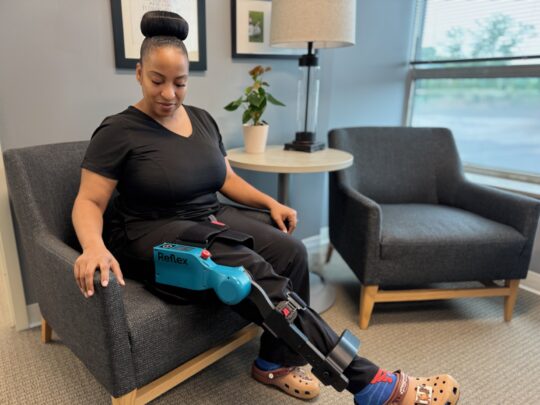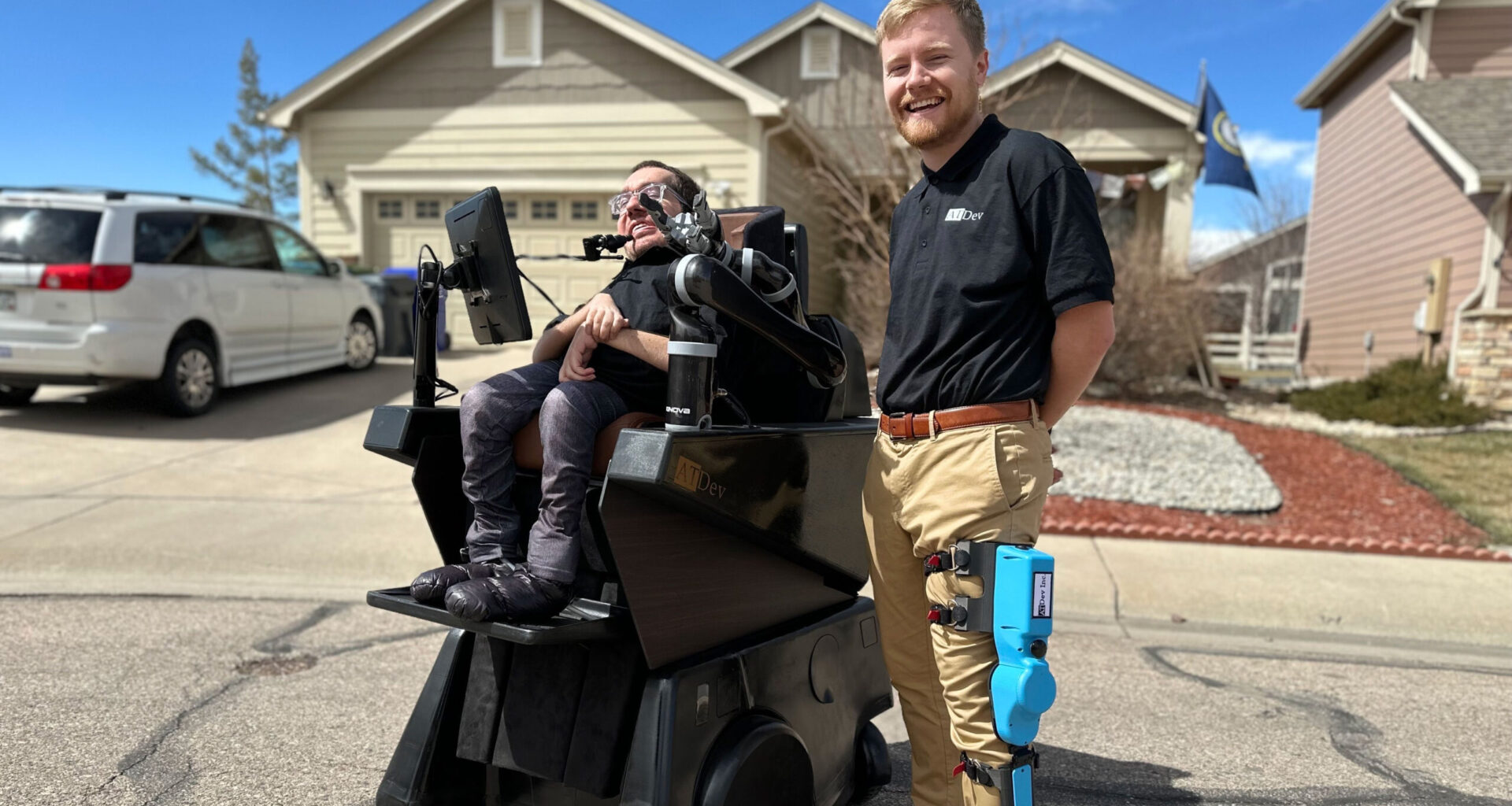October 20, 2025 by Marni Ellery
With a little serendipity and lots of grit, alumni Todd Roberts (MEng’20 ME) and Owen Kent (B.A.’17 Film) have shown how an idea can turn into a product that makes a difference. The pair first developed Reflex, their robotic rehabilitation device, in a UC Berkeley course on assistive technologies. Now, six years later, they’re launching it through their company, ATDev, which aims to bring high-quality rehabilitation into the home.
The two met when Roberts, an incoming graduate student, responded to Kent’s Craigslist post advertising a room for rent. They became fast friends and, once classes started, realized they were both in Designing for the Human Body, a biomechanics course taught by mechanical engineering professor Grace O’Connell.
Kent, who had graduated from Berkeley a few years earlier, was the class mentor and interested in ways to innovate in the assistive technology space. “As a lifelong wheelchair user born in the early nineties, I’ve seen a lot of technology changes and have directly benefited from these new things,” he said. “I really want to contribute to that ecosystem professionally and dedicate a big portion of my life to building new things that hopefully improve people’s lives in the future.”
Roberts was introduced to assistive technologies while studying mechanical engineering as an undergraduate student at Northeastern University. Initially interested in exoskeletons, he came to Berkeley to pursue an MEng in mechanical engineering with a focus on biomechanics. His friendship with Kent helped cement his decision to build a long-term career in this space.
Kent first proposed the idea for Reflex in O’Connell’s class. “I had recently gotten a robotic arm attached to my wheelchair, and I was noticing that I was using it to reposition my body, which I couldn’t otherwise do,” he said. “I pitched the idea of trying to use lightweight, wearable robots to do daily physical therapy.”
According to Roberts, O’Connell’s class provided the perfect environment to pursue this idea together. “Grace had in place a mentorship program where students worked on a semester-long project,” he said. “During the fall semester, my student team and our mentor, Owen, did the initial research, then Grace helped our group set up an independent study for the spring semester. Afterward, we applied for a small grant from the Jacobs Institute for Design Innovation and were awarded $3,000 to build some prototypes that spring.”
Added Roberts, “The whole time, Grace was both guiding us from a technology perspective and cheering us on as we put in the energy and the time into a project. As our advisor, she kept laying out the yellow brick road, putting new opportunities in front of us.”
For O’Connell, it was gratifying to watch Kent and Roberts take a concept and turn it into a product with human impact. She hopes their work will encourage other students to pursue careers in the medtech space.
“The collaboration between Owen, as an external client, and Todd’s team in Designing for the Human Body truly embodied what I hope students take away from the course — using human-centered-design to solve real-world problems and improve human health,” said O’Connell. “Seeing their partnership grow from a class project into a product helping patients is something that I hope will inspire future students.”
Kent and Roberts’ efforts eventually led to the creation of Reflex, a device that looks like a knee brace with a robotic motor attached to it. Patients are individually fitted for the device, which is then delivered to their home. In accordance with the treatment plan, Reflex can apply either supportive forces that move the patient’s leg back and forth to restore range of motion, or resistive forces to build quadricep and hamstring strength.
While in use, the device is collecting patient data, including how well they are doing the prescribed exercises. That information is then sent to the patient’s care team, so they can remotely monitor and update parameters.
“Through this closed loop telehealth experience, the patient’s care team can determine whether they are meeting their goals and make recommendations, including returning to a clinic for more care,” said Roberts. “Owen’s original idea was to make physical therapy more accessible through low-cost, lightweight robotics. And that’s effectively what Reflex does.”
After they incorporated, O’Connell helped guide them through the grant writing process and connected them with the NSF I-Corps program, which awarded Kent and Roberts their first federal grant.
“We were given $50,000 to go out and interview a hundred-plus potential customers within three months,” said Roberts. “From that experience, we learned a ton about our market and pulled the engineering hats off to focus on how to sell this device.”
Added Kent, “Berkeley also provided incredible mentoring. The Haas School of Business offered free office hours, including legal counsel. That was how we met our attorney, who has helped guide us through this process, including incorporating with our early IP and even helping us with a lot of our fundraising.”

Reflex enables patients to do at-home rehabilitation and sends data to their care team. (Photo courtesy of Owen Kent and Todd Roberts)
Along the way, Kent and Roberts engaged with Berkeley SkyDeck. In addition to providing advising and networking opportunities, the program taught them how to build a pitch deck, a tool that would prove invaluable as they set their sights on raising money from investors. Soon after, Berkeley SkyDeck wrote them a check for $200,000, their first-ever venture investment.
“That gave us some actual runway and helped us transition in the first 2 ½ years,” said Roberts.
Once Reflex received FDA approval in April, Kent and Roberts were able to register their product and begin sales. They are currently shipping the device to Veterans Affairs hospitals and private physical therapy clinics, and, with additional funding, they hope to refine the design for mass production. They also are exploring ways that their device could be used to help with rehabilitation for neuromuscular conditions such as stroke recovery.
This fall, Roberts will come full circle when he returns to O’Connell’s class to give a guest lecture.
“One of Grace’s goals in starting the Designing for the Human Body class was to teach mechanical engineers that there’s more than just the automotive industry in terms of jobs,” he said. “My hope is that, after listening to my talk, students will realize that if they’re passionate about something, they can spin it up and make an impact — just don’t expect it to happen overnight.”
As for Kent, he wants students to know they have access to a robust ecosystem. “Berkeley has an endless list of resources for entrepreneurs. So it’s about taking advantage of those opportunities and networking as much as you can,” he said. “You never know who you’ll meet that will enable you to do your next thing.”

